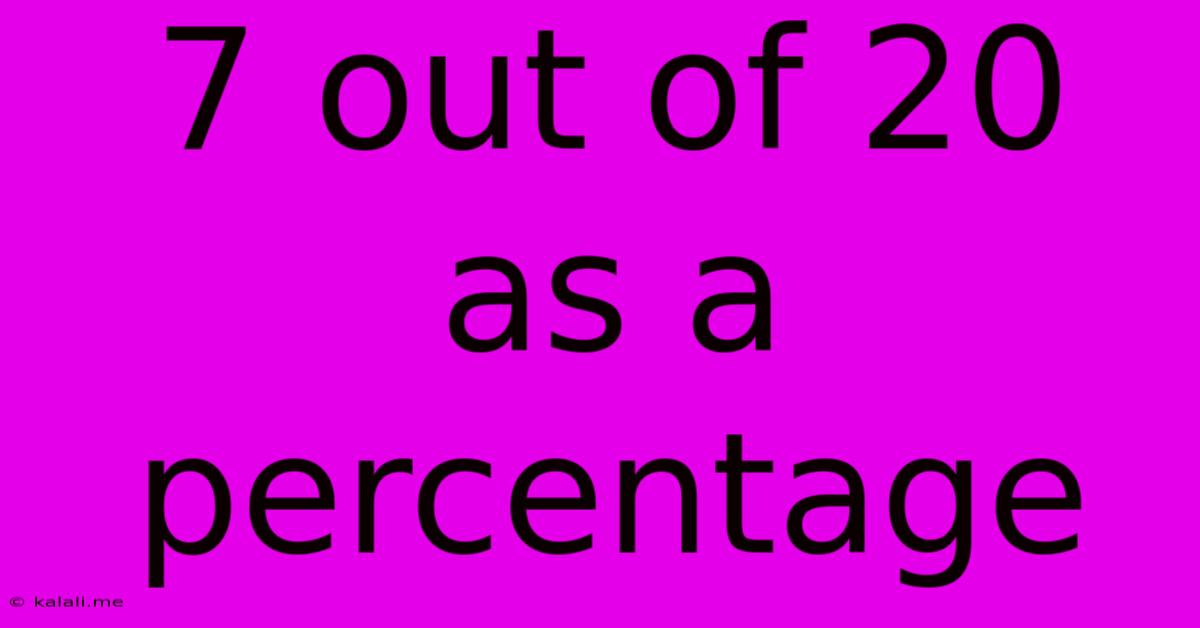7 Out Of 20 As A Percentage
Kalali
May 09, 2025 · 2 min read

Table of Contents
7 out of 20 as a Percentage: A Simple Guide
Understanding percentages is a fundamental skill in various aspects of life, from calculating discounts to understanding statistics. This article will guide you through calculating 7 out of 20 as a percentage, explaining the process step-by-step and providing context for similar calculations. Learning this simple method will equip you to tackle a wide range of percentage problems.
What does "7 out of 20" mean?
The phrase "7 out of 20" represents a fraction, indicating that 7 parts out of a total of 20 parts are being considered. To express this as a percentage, we need to convert this fraction into a form that expresses the proportion relative to 100.
Converting a Fraction to a Percentage
There are two primary methods for converting a fraction to a percentage:
Method 1: Using the Decimal Equivalent
-
Convert the fraction to a decimal: Divide the numerator (7) by the denominator (20): 7 ÷ 20 = 0.35
-
Convert the decimal to a percentage: Multiply the decimal by 100: 0.35 x 100 = 35%
Therefore, 7 out of 20 is equal to 35%.
Method 2: Direct Percentage Calculation
This method involves setting up a proportion:
-
We know that 7 out of 20 is equivalent to x out of 100 (which represents the percentage). This can be expressed as a proportion:
7/20 = x/100
-
To solve for x, cross-multiply:
20x = 700
-
Divide both sides by 20:
x = 35
Therefore, 7 out of 20 is equal to 35%.
Understanding the Result: 35%
35% signifies that 7 represents 35 parts out of every 100 parts. This percentage can be applied in numerous scenarios. For example, if you answered 7 questions correctly out of 20 on a test, your score would be 35%.
Practical Applications of Percentage Calculations
Understanding percentage calculations is crucial in various real-world situations, including:
- Calculating discounts: Determining the final price after a percentage discount.
- Analyzing data: Interpreting statistical data represented as percentages.
- Calculating interest: Understanding simple and compound interest rates.
- Assessing performance: Evaluating progress against targets expressed as percentages.
- Financial planning: Managing budgets and investments.
Conclusion
Converting fractions to percentages is a straightforward process, as demonstrated with the example of 7 out of 20. By mastering these techniques, you'll be better equipped to handle a variety of mathematical and real-world problems involving percentages. Remember to practice these methods to build your understanding and confidence in handling percentage calculations. This will undoubtedly prove beneficial in your personal and professional life.
Latest Posts
Latest Posts
-
How To Subtract A Whole Number With A Mixed Fraction
May 09, 2025
-
How Much Is 37 Inches In Feet
May 09, 2025
-
Cuanto Es 50 Gramos En Onzas
May 09, 2025
-
How Does Water Change The Shape Of Earths Surface
May 09, 2025
-
What Is 16 Out Of 25 As A Percentage
May 09, 2025
Related Post
Thank you for visiting our website which covers about 7 Out Of 20 As A Percentage . We hope the information provided has been useful to you. Feel free to contact us if you have any questions or need further assistance. See you next time and don't miss to bookmark.